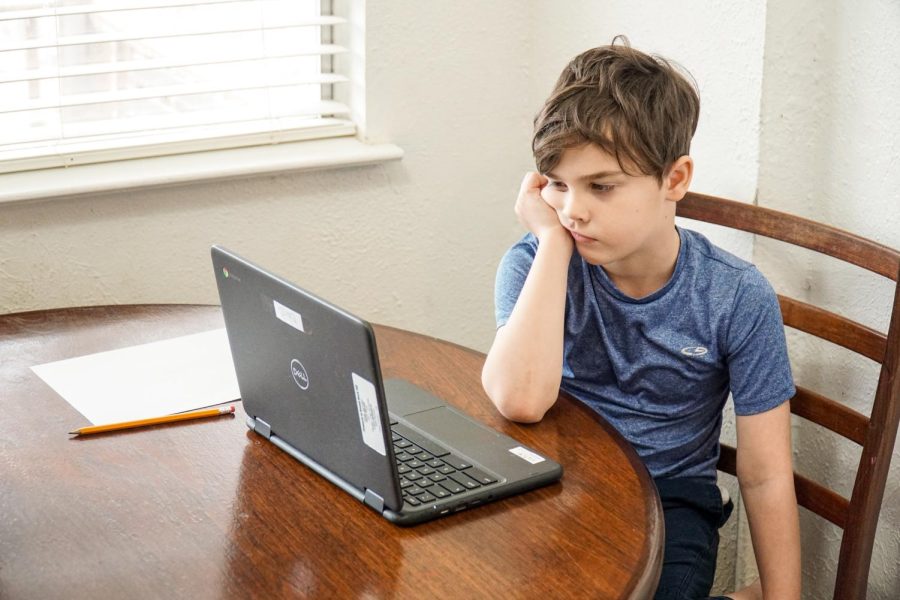OP-ED: How the Pandemic Has Highlighted the Systemic Problems of US Education
December 4, 2022
We all have memories of the pandemic, from wearing masks to staying locked in our houses for months on end doing Zoom sessions. But one impact that has endured since the onset of the pandemic has been its effect on widening the gap between students along socioeconomic and racial statuses in the American school system. A recent study has found that reading and math scores dropped substantially during the pandemic for 9-year-old students in the United States. While the decline as reported in this study has affected the entire country, there has been a disproportionate decline in scores among students of color. Gaps like these, however, have always existed. The SAT, for instance, is known for reflecting salient disparities between low and high-income students. Systemic issues have been fueling this gap for decades, which the pandemic has only exacerbated.
The pandemic was marked by an era of virtual learning, which proved to be especially harmful to students of color and low-income students. These impacts emerged because of a lack of adequate and reliable internet access and modern technology available to these populations dubbed the “Digital Divide”, and has been present long before the pandemic. Richer schools and families adapted to the changing circumstances more easily due to having better access to these technologies. Research has shown that poorer students are less likely to have access to home broadband or devices like smartphones. The larger issue with this divide, however, is that it disadvantages those with less access to technology as they may not receive the benefits of the Internet like watching YouTube videos to learn material for their classes, finding additional worksheets to practice concepts, or doing research for projects. In fact, while a majority of students rely on Internet access to be able to complete their homework, students of color and low-income students are most likely to have inadequate access for this purpose.
More privileged families are also more likely to have the means to afford supplemental resources like tutors, thus being able to help their students through the educational challenges they face. These families were more likely to resort to these resources during the pandemic and thus worry less about the ramifications of the pandemic on their children’s learning. About 20% of upper-income families hired a tutor to help their children during the pandemic, compared with just 8% of lower-income families, despite the fact that those with lower incomes reported being the most worried about their children falling behind in schoolwork. This has always been a problem, though, as these more privileged families had always had the advantage of being able to assist their children academically in this manner when they were struggling.
The home environments that students learn in also contrast between students along socioeconomic lines. Poorer students are more likely to live in smaller households in comparison to their richer counterparts who may be able to have a separate room where they can focus on their work. This became a problem for many students during the pandemic who were struggling to focus on their classes in households that were more tightly packed. In a broader context, this issue transcends the pandemic, as this has always been a problem for poorer students who may live in environments that may not be as conducive to studying or doing homework.
One other issue that has existed for decades has been that public schools have generally been funded by property taxes. Property taxes are imposed on the value of the properties that people in an area own, with the implication that properties of higher value will generate more revenue than those of lower value. Thus, people of lower socioeconomic status who are more likely to own lower-value properties will be contributing less money to their child’s public school. Connecticut is one of the wealthiest states in the nation, but its schools in areas with high poverty rates suffer disproportionately since approximately 59% of its education funding comes from property taxes. The result of this is that schools in poorer communities have less money to buy books and modern equipment, and retain teachers with better salaries, thus creating worsened outcomes for students living in these communities. This problem was exposed during the pandemic, in which schools in poorer communities struggled to reopen schools in part due to relatively inadequate funding to meet public health recommendations like improving ventilation systems or purchasing personal protective equipment even when given stimulus relief money. These districts were also burdened with additional needs to buy laptops or subsidize Wi-Fi for their students during the initial switch to virtual learning compared to wealthier districts.
All of these disparities lead to a negative feedback loop. People who grow up poor tend to have fewer resources and opportunities to receive an adequate education, making it more likely that they will not graduate from high school, and thus creating a host of risks – being unemployed, becoming more likely to be reliant on government welfare, going to prison, and having a lower income. Those trapped in these circumstances may then have offspring that also go through the same experiences, thus largely being permanently disadvantaged.
So how can this be fixed? The only way to end this discouraging cycle is to address the root causes that have been fueling it. This will require the work of local, state, and national governments to find ways to solve the factors that have created this problem. The Internet has the potential to be the greatest equalizer that can close the gap if access to it is equitable. This may mean that there will need to be more government programs to subsidize broadband access and devices for lower-income families to end the Digital Divide. This access could also enable families to more easily access online tutors or resources necessary to help their students. Additionally, while the government may not be able to solve the issue of differences in home environments, it can invest more into infrastructure like public libraries that will create areas for students to be able to adequately focus on their work. Lastly, rather than funding schools through property tax, the government should distribute money equitably between schools while increasing investment across the board in education to ensure access to resources within schools. It is when solutions like these are adopted that we can truly close the gap and make America a land of equal opportunities.








